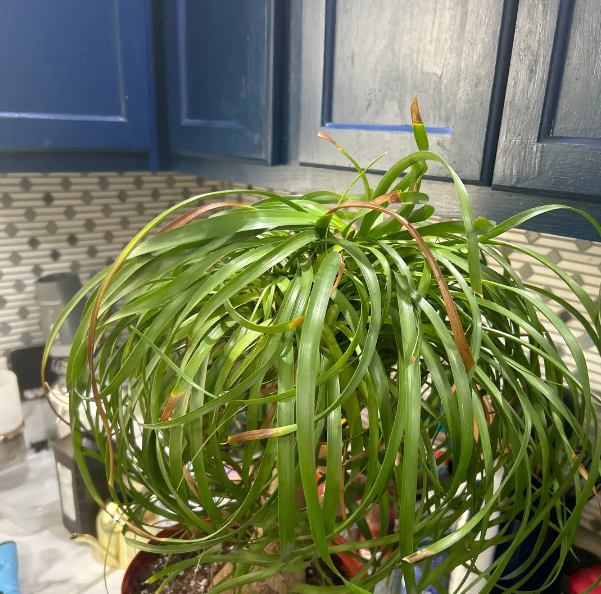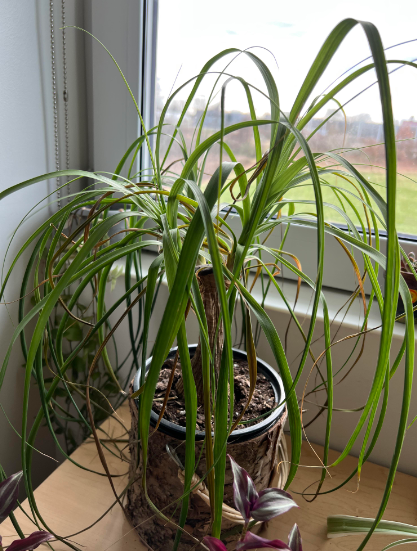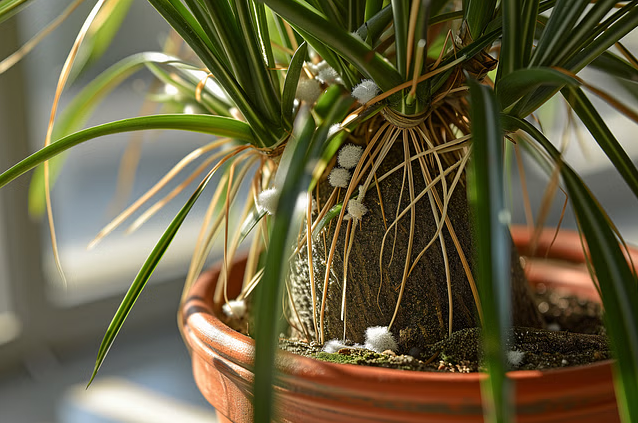Welcome to the enlightening guide on how to keep your ponytail palm thriving. Here, we will go in-depth into the very common problem of brown tips on your plant. It’s very important that you learn the fine details about brown tips on a ponytail palm to further encourage a healthy botanical buddy.
Proper care, ranging from the best technique for watering to perfect lighting, makes all the difference in optimal growth and maintaining well-being for your ponytail palm. Let’s embark on this journey of horticultural knowledge, tailored to elevate your plant parenting skills and grow a thriving green oasis.
How to Identify Brown Tips on Ponytail Palms
Brown tips signify possible maladies in the health of your ponytail palm. These brown tips can come from incorrect watering applications, a lack of light, or inappropriate environmental conditions. Being able to recognize these is important for the good care and well-being of your ponytail palm.
By identifying brown tips on your ponytail palm, you reassure yourself that you take all necessary steps to care for the underlying problem before it gets out of hand. Proper adjustment of watering frequency, careful light exposure, and optimal temperature and humidity are good enough reasons for the prevention or cure of brown tips. Often, attentive observation followed by timely intervention is a must in the general health of your plant.
The brown tips on your ponytail palm are a good way to measure its current state. One should give them frequent checks in order to pay proper attention to their needs and prevent further deterioration. If you understand properly what is happening and intervene timely, you’ll be able to make the right move in managing brown tips on your ponytail palm and let it thrive healthily.
In fact, brown tips in your ponytail palm express their meaning as a great way to understand how to care for your plant. You can keep it healthy and in excellent condition once you address the symptoms in time and use proper care practices. Be very attentive to your plant and respond with proper care in order to enjoy its beauty for a long time.

Correct Watering Techniques
Proper Watering Techniques Proper water techniques are critical to the health of your ponytail palm. This plant prefers well-drained soil, and for this reason, it will be important not to water too much. Make sure the top few inches of soil have dried out between waterings to prevent root rot and yellow leaves.
When watering the ponytail palm, do so making sure the water is deeply absorbed by the root zone. Deep and infrequent irrigation helps the plant establish a very solid rooting system, thus enabling extra water to run out of the pot’s drainage holes. This way, its avoidance of any waterlogged conditions that normally cause brown tips in the leaves of this plant is ensured.
Watering slightly more frequently during the growing season-spring and summer-should be done. Monitor the soil moisture by checking the top layer of the soil. Depending on your plant’s requirement and condition, adjust the watering schedule accordingly to keep it in healthy active growth with vigorous foliage. Properly watering your ponytail palm prevents brown tips from appearing on your palm and will help in creating well-being within the plant.
Ideal Lighting Conditions
- Ponytail palms thrive in bright, indirect light, making them perfect indoor plants in well-lit spaces. Direct sunlight can scorch their leaves, leading to browning tips.
- Place your ponytail palm near a south or west-facing window where it can receive adequate sunlight throughout the day. If natural light is limited, supplement with artificial grow lights.
- Avoid placing your ponytail palm in dark corners or shaded areas as this can stunt its growth and increase the likelihood of brown tips due to insufficient light exposure.
- Remember to rotate your plant regularly to ensure even light distribution, promoting balanced growth and preventing tip browning from light deprivation.
Temperature and Humidity Considerations
Temperature and humidity are the most vital considerations in taking care of your ponytail palm. The plants require temperatures that range between 65-75°F, which is essentially 18-24°C. Plants would prefer to stay under average humidity levels. Avoid exposing the plants to extreme temperature differences or long cold drafts, as that may stress out the plants and eventually turn the tips of the plant leaves brown.
About the aspect of humidity, the plants love to stay in a moderate level of 40-50%. In case your indoor atmosphere is quite dry, periodic misting or even putting a tray of pebbles and water below the plant should raise it accordingly. However, don’t overwater to the point that it gives root rot or other complications.
It is a good thing to raise the humidity around your ponytail palm during winter when heating might make conditions drier. You do this by setting plants together or by placing a humidifier in the room; this will give your ponytail palm a better climate. With proper temperature and humidity in place, your plant will be in great health and won’t develop brown tips.
Pruning and Grooming Practices
Other important methods of taking good care of your ponytail palm are pruning and grooming. Browning of the tips is a common thing, and it is one of the practices used to further encourage the growth of new tips by preventing the browning from fully spreading out. Using clean, sharp scissors, make angled cuts following the natural growth of the plant.
Besides getting rid of brown tips, removing dead leaves is important for the overall aesthetic of your ponytail palm. Take dead or yellowing leaves from the base of the plant and carefully pull them away to avoid causing further damage to other healthy leaves. The process not only enhances the appearance but also reduces the risk of infestation.
Regular grooming sessions also mean that you will have the opportunity to inspect your ponytail palm for diseases or, worse, bug infestations. A clean and well-groomed plant means that you’ll catch these problems in time and do something about them. Remember, good pruning and grooming mean a healthy, lively ponytail palm continuing to beautify space indoors and outdoors.
Trimming Browned Tips
Pruning the brown tips of your ponytail palm is a very important part of grooming for your plant’s looks and health. Once browning has begun at the tip of a leaf, immediate action must be taken to prevent further damage and promote new growth. Carefully make a cut with clean, sharp scissors or pruning shears near the browned part. Try this in such a way that you cut slanted to save the natural appearance of the leaf for aesthetic reasons and also perhaps so that you may not stress the plant needlessly.
Make sure you cut only pieces of the leaves where there is actual browning and don’t touch the healthy green areas. This pruning ensures that your palm will look better, and at the same time, it encourages the plant to focus its energies on the most thriving parts of it. After pruning, make sure to closely monitor the plant for new growth, ensuring browning issues are taken care of as soon as possible. Besides that, give your ponytail palm regular inspection and maintenance routines to keep it fresh and healthy.
Not to forget, the pruning of browned tips is one part of your care for the ponytail palm. For the general health of your plant, proper watering and adequate lighting, along with fertilizing, all have important concerns. Take care of its needs wholistically, and your ponytail palm will serve both aesthetic and health functions.

Safe Removal of Dead Leaves
Knowing how to safely remove dead leaves is important, especially when it comes to the health and good appearance of your ponytail palm. Dead leaves detract from the general look of the plant, besides attracting some pests or diseases if left unattended. Here are some tips for safe removal of dead leaves on the ponytail palm:
Inspect the Leaves: Before removing any dead leaves, carefully inspect the plant to identify which ones are truly dead. Dead leaves are typically brown and dry, while healthy leaves are vibrant green. Gently tug on the leaf – if it comes off easily, it is dead.
Use Clean Tools: To prevent the spread of diseases, ensure that your pruning shears or scissors are clean and sharp before removing any dead leaves. Wipe the tools with rubbing alcohol or a disinfectant before and after use to avoid transmitting any pathogens.
Cut at the Base: When removing dead leaves, make clean cuts at the base of the leaf stem, where it meets the trunk of the plant. Avoid tearing or ripping the leaves, as this can cause unnecessary damage to the plant and leave it vulnerable to infections.
Dispose Properly: After removing dead leaves, dispose of them properly to prevent any potential spread of disease. Seal them in a plastic bag before discarding them in the trash. Do not compost dead leaves from your ponytail palm, as this can introduce pathogens back into your garden.
Fertilizing Directions
Fertilizing directions play a big role in taking good care of your ponytail palm. Choose a balanced formula, preferably a water-soluble fertilizer with a high middle number, which corresponds to phosphorus for root development. Avoid over-fertilization since it may cause build-up and toxicity to the plant.
Feed the plant regularly, especially during spring to early fall, when it is at its active growth stage. Follow the instructions on the package, usually diluted, since a high nutrient feed might burn the plant. This consistency feeds the plant the nutrients it needs for better health.
Also, consider the special needs of your ponytail palm when it comes to choosing any fertilizer; be sure the fertilizer contains nutrient elements like nitrogen, phosphorus, and potassium. Go for a slow-release fertilizer to avail the nutrients in time for a quite long period, which will enable it to have this slow and sustained growth. Application of fertilizers regularly, together with correct watering and lighting, ensures lush, healthy leaves.
By following these Fertilization Guidelines strictly, you’ll be enhancing the strength and vigor of your ponytail palm while reducing the tendency for brown tips to develop in order to give you a healthy indoor plant. Keep in mind that a balanced fertilization approach-one that caters to the needs of your plant-is what will help in fostering a thriving ponytail palm in your home.
Selecting the Apropriate Fertilizer
While trying to choose the proper fertilizer for your ponytail palm to get the brown tip problem under control, you should go for a balanced liquid houseplant fertilizer. Look for a formula designed for succulents or palms to add essential nutrients but avoid over-fertilizing your plant. Here are key points to consider:
- Look for a fertilizer with a low nitrogen content to prevent excessive leaf growth, which can stress the plant.
- Choose a fertilizer that includes micronutrients like iron and magnesium to support overall plant health.
- Consider slow-release fertilizers to provide a steady nutrient supply over time, reducing the risk of fertilizer burn.
- Follow the manufacturer’s instructions for mixing and application to avoid damaging the plant’s roots.
By choosing the right fertilizer and applying it well, you can definitely set your ponytail palm on its way to good health and prevent further browning of its tip.
Feeding Schedule for Healthy Growth
Establish a regular feeding schedule to ensure the growth and good health of the ponytail palm. Use a balanced fertilizer that has high phosphorus content for root development and, generally, plant vigors. Feed your ponytail palm once every 4-6 weeks during the active growing seasons, spring and summer. During fall and winter when plants go into their dormant phase, feeding should be less frequent, once every 8 to 12 weeks, so it aligns with the natural growth cycle.
A very key issue in good feeding is not over-fertilizing, which will only bring nutrient imbalances and might even harm the plant. Watering the fertilizer down to half or a quarter of the recommended strength will prevent the burning of your ponytail palm’s roots. Also, make sure you water the plant properly after fertilizing it to ensure good delivery of the nutrients and avoid salt build-up in the soil.
Observe the growth and look of your ponytail palm closely for any changes to the above schedule. If it is growing very slowly, the leaves are pale, or just generally declining in health, this could be due to the need for feeding more often or having another fertilizer formulation. As you follow the consistent and well-balanced feeding schedule, the growth of your ponytail palm may be healthy with vibrant foliage all over the year.

Monitoring and Preventive Care
The ongoing monitoring and preventive care for your ponytail palm is greatly considered in building ongoing health and preventing some of the common problems. Give your plant an occasional inspection check, especially for brown tips or yellowing leaves. This frequent checking of the general appearance of your ponytail palm enables you to take immediate action concerning problems that may be developing and halt further deterioration.
Aside from the ocular checks, one must also ensure that a good watering schedule is given; this will also ensure that specific problems, like root rot, do not arise. The browning of the tip can often be because of excessive watering. Therefore, proper adjustment of the watering schedule, depending on the plant’s and environmental needs, should be considered. Proper care in terms of watering will go a long way in ensuring health for the plant and preventing browning of the tips.
Besides, these errors in illumination could be avoided if the setup of lighting is according to the needs of the ponytail palm, since it would avoid sunburn and drying at the tips. It needs decent sunlight, but not direct. Also, dusting on the leaves and occasionally gently cleaning them with a wet cloth can prevent dust accumulation on top of the leaf and ensure that it absorbs the right amount of light to grow healthy.
With proper fertilization given on a regular basis to your ponytail palm during the growth period, nutritional deficiencies that may further cause browning of the tips will be avoided. Of course, the application of proper feeding schedules and proper fertilizer for succulents will always maintain their health and avoid problems that always concern each plant owner. This proper fertilization, together with good monitoring and care, enables the ponytail palm to retain its vigor and develop well in favorable conditions.
Watering correctly is one of the most important things you can do to ensure you don’t have brown tips on your ponytail palm. Use well-draining soil that does not become waterlogged, which could cause root rot. Water your plant well but keep the soil a little dry after each watering. Overwatering is generally the culprit when you have browning tips on this plant.
Besides that, high lighting is important to keep your plant healthy. It will be much better if the ‘Ponytail Palm’ stays in bright, indirect light. One should not let the plant stay under direct sunlight for long because the leaves might get burned, turning their edges brown. Keep your plant in good light for a healthy look; this would help you eliminate the possibility of browned leaves.
Your ponytail palm does well with appropriate temperature and humidity. They will like temperatures within a range of 65-75°F and average humidity. Extreme temperature fluctuations, in addition to cold drafts, may cause stress in the plant and therefore the browning of the leaves at their tips. Keep all balanced to give your plant the best health and least amount of brown leaf tip problems.
Ultimately, with the appropriate care practice, as outlined in this book, you should be in a position to resolve and prevent brown tips on your ponytail palm. Remember that proper proportions of water, light, temperature, and grooming will result in the plant’s health and vigor.
Through monitoring, watering, pruning, and care conditions, the best possible proactive approach will be taken in making sure your ponytail palm stays healthy and full. Inclusion of these in the best practices routine for your plant care will help you to have a thriving, healthy ponytail palm for many years.
